My first prototype for what I can do came in the form of a Twine storyboard for the series of action the player can go through. While I was aiming for a more ambitious second part of the story, The professor suggested I take a step back from making art and designing code to keep working on my story and the outcomes of each interaction. I started with the intro and the first few questions. I had not gotten very far in terms of what I wanted, but the professor and some other students gave me direction on the story and what I should do for the second prototype. I should write more story and interactions of what I want to have happen and create different endings, which will be the visuals. The story and actions must come first in terms of what I want to make
Prototype: One
In this first prototype, my goal was to make progress in the field of NPC and quest creation for a Fallout 4 mod. So what I did to accomplish this was, first of all, to find a good tutorial to follow along with. As it turns out with me, the best way for me to learn this kind of stuff is to follow along with an example. So I did just that with this tutorial from the Creation Kit website. I ended up learning a whole lot from this tutorial, including but not limited to, NPC creation, dialogue creation, quest structure, and object scripting. All in all, this wasn’t an overly difficult prototype. The hardest parts were when I messed up a line of code with a typo somewhere and had to frustratingly backtrack to find my error. All the steps I learned, while not too complicated in and of themselves, end up weaving together to create the complex structure that makes up a quest in game.
This experience has really helped me to understand just how expansive and or complex I should make this mod. While quest and character creation isn’t the hardest thing in the world, it is very time consuming, so I’ll really have to gauge the types and amount of quest that I’m going to do. Also, it taught me how dialogue is recorded, which as it turns out is pretty easy. The program already has a built-in recorder for the lines you need to record. Pretty handy considering I thought I’d need a separate program for that. At the end of the day, with everything I’ve learned so far, I’m still fully on track for the rest of my project.
Research Update 1
RESEARCH
Platinum Studios
Platinum Studios was founded in 2006 and they currently have 209 employees. The head office is located in Osaka, Japan. Over the last few years, they have developed NieR:Automata, Teenage Mutant Ninja Turtles: Mutants in Manhattan, Bayonetta, and Star Fox Zero and Star Fox Guard.
Platinum excels at their development of battle/combat games. They actually co-produced NieR:Automata because the other producer did not have the experience or the desire to create the required battle/combat system.
Platinum games method for development of a game is to first develop how the character is to play. In addition, the action the players can take in game design is referred to as “verbs”. It is important not to have too many verbs so the controls do not become cluttered. Verbs serve multiple functions such as flushing out the development/skills of a character. Verbs also lead to better game design.
An example of a verb in Platinum Games that highlights the above was in one of their first projects, Bayonetta. In Bayonetta, they used a well-timed dodge to slow down time. This verb was used both in combat and in the puzzles between sections. This gave the character the assumed knowledge of how to combat but also gave the game player the ability to elude or fight without actually throwing a punch.
For me I am taking Montgomery Harris’ rule of six and distilling my verbs down to six actions. I have not finalized this list as I continue to compile the list of verbs before finalizing.
I have also researched Hideaki Itsuno. He is the mind behind the later “Devil May Cry” series, which set the bar, which all other similar games are compared. Hideaki is a Japanese video game director and video game designer employed by Capcom for most of his career. He is credited as the director of Power Stone, Devil May Cry and Dragon’s Dogma series’. Although he did not direct/design the original Devil May Cry game, he did become involved with Devil May Cry 2 to steer the project back on course. He was then involved starting on Day 1 with Devil May Cry 3 and 4.
https://en.wikipedia.org/wiki/hideaki_itsuno
The more I considered what I wanted to achieve I realized my greatest inspiration is the game Dead Cells – simple 2D game with approximately 5 verbs relating to combat. Motion Twin developed this game, which is a French worker cooperative based in Bordeaux, France. They have been making games since 2001 and are currently working on their first PC/Console title. Dead Cell has three consistent verbs of run, dodge and jump. Two of the actions the player can take, and the game is set up so you randomly get two weapons and two skills. Thus, all those randomized weapons can fit into the verb attack and all the skills can fit into the verb skill. Because of the player is always on the feet with hundreds of options to approach a situation. Because the players’ movement is consistent, it give the players the confidence to take risks and progress through the game. This is something I appreciate and am looking to incorporate into my own game.
Game Design – Unity
As discussed, my desire is to build my game utilizing Unity. Therefore, my research has been focused on the coding in Unity. This is progressing however I have yet to get the enemies working but the player can attack and run around from left to right.
To build upon this I have also visited Linda.com which provides video trainings to continue learning and understanding the basics of Unity. I am using this to better translate the movement I want to achieve with my characters. Although I was able to increase the speed of the characters, it was negatively affecting other facets of my game design so I am further researching how to address these issues.
Game Design – How To
One great resource I have found is the YouTube channel “Extra Credits”. I have viewed their whole series on making your first game and I continue to research this information. Extra Credits states your first game should be small in scope and when putting your game plan together, break it into smaller achievable chunks. They recommend having small weekly objectives to maintain a steady progressive pace to achieve them.
https://www.youtube.com/user/ExtraCredits
My research continues as I build upon what I am learning and applying to my project.
Pictures from Thy Geekdom Con
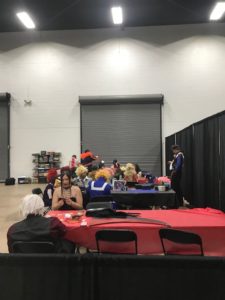
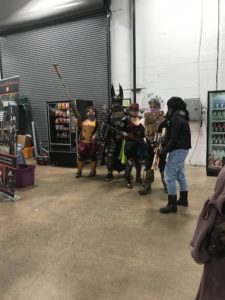
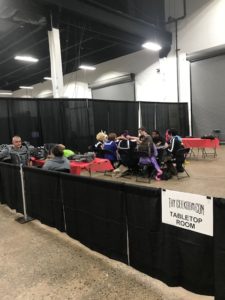
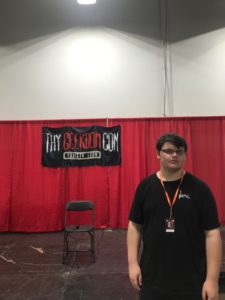

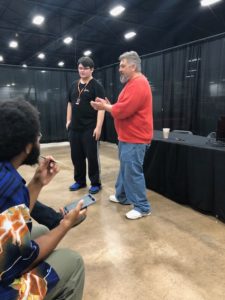
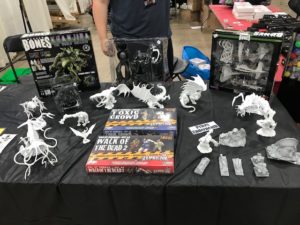
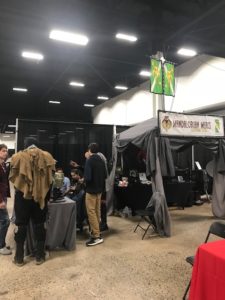
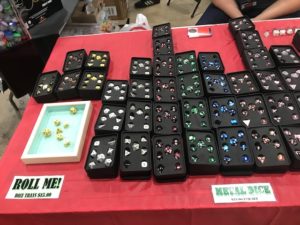
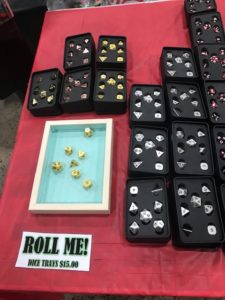
Report on Industry Event: Thy Geekdom Con
Max Shaver
November 4, 2018
On Saturday, November 4, 2018, I attended the “Thy Geekdom Con” at the Greater Philadelphia Expo Center in Oaks, Pennsylvania. The convention was a three day event consisting of Panels, Variety Shows, Workshops, Gaming and Vendor Booths. I have attended other ‘Cons’ previously and in comparison this was a smaller convention with fewer attendees, however, you still had individuals participating in cosplay, numerous vendors sharing their wares and similar individuals to myself which love gaming, anime and stories. Of particular interest during this Con was a panel being led by Montgomery Harris titled “Creating Your Own Universe”. Mr. Harris was in the military and then once he got out he began to write scenarios for Military Simulations and Live Action Role Play games. More recently he has authored the novels “Outbreak Z: Morbus” and “Outbreak Z: Salvos” released in late 2017 and “Scarlet Cross: The Sixth City” and “Outbreak Z: Damnum” and “Scarlet Cross: A Voice Like Thunder” in 2018. What I heard from Mr. Harris truly strengthened my understanding of how important a video games universe is in the success of your user’s gaming experience. Montgomery explained how his military training and the overabundance use of acronyms lead him to apply “Dog’s Bollocks” to all of his writing efforts in developing a believable and readable universe. He also shared the rules of six which also greatly influences how your users enter a game and how that will drive the user to continue with your game or to leave your game shortly after beginning. For Harris, “Dog’s Bollocks” means the following
- Do your Research
- Begin
- Organize
- Locations
- Outline
- Kill your darlings
- Start writing
For the rule of six, when you begin you need to develop what is/was happening in your universe
- 6 years ago
- 6 months ago
- 6 weeks ago
- 6 days ago
- 6 hours ago
- 6 minutes ago
- 6 seconds ago
Then apply six to everything. Have six locations, six core characters, six event, and your characters should have six main traits, etc. This will provide you with a sound foundation for your universe so you can begin writing your story or the game you are creating. I thought when applying that to video games and realized video games are universes you are literally interacting with. What Montgomery was doing was creating a world the user would believe and imagine. I applied the rule of 6 and thought about what user would do in first 6 seconds then the next 6 minutes and what they would do in the remainder of the game. In considering all of this I have identified multiple examples which support my thoughts and will continue to explore this as I complete my thesis project of the gaming world I want my players to interact in.
The Prototype Plan
- For the first prototype, I will sketch out how the project will run. I’ll draw out how it’ll look on screen and how it’ll look physically on the user’s hand.
- For the second prototype, I will start taking photos of someone’s hand in a crocheting position to get a closer look at how I should be structuring the hand, crochet hook, and pattern within Unity.
- Lastly, for the third prototype, I will start drawing up code within Unity to get a feel and an idea for what I will be working with when I begin my overall project.
Research Update 3/3
This week, I’ve been looking more into what programs I’ll need to use for my thesis. As I mentioned in my last post, I’m thinking of using Unity and possibly a Leap Controller device. In this week’s post, I’ll go a bit more in depth with my plan on learning these programs.
To learn more on Unity, I’m going to invest some time into watching Lynda and YouTube tutorials. Here are a couple ones from YouTube that should be helpful:
- https://www.youtube.com/watch?v=Au8oX5pu5u4
- https://www.youtube.com/watch?v=qX8kabgz3wo
I also plan on talking more to my alumni advisor Andy as well as Prof. Josh Fishburn and my good friend Robin who are all more familiar with Unity than I am.
Josh teaches Games I and Games II in the IMM department. Occasionally, I will sit in on his Games I class with Robin to listen to the lecture and watch Robin build his game. So, this gives me the perfect opportunity to talk to Josh and Robin about using Unity in my project.
Then, through email, I’ll continue to communicate with Andy and ask him for some helpful tricks and techniques. Maybe at some point he’ll be able to come to TCNJ to help me and other students who have been assigned to him.
As for learning how to use a Leap Motion Controller, that’s another thing I will ask Andy about as well as Dr. Nakra (who I believe has worked with Leap Controllers), and look up directions and tutorials on. I’ll also need to look into how I would be able to access a leap controller for my project.
Here are some videos I found relating to connecting a Leap Controller with Unity:
- https://www.youtube.com/watch?v=8KeZxfPh8TE
- https://www.youtube.com/watch?v=Wh3YK2OcI4M
- https://www.youtube.com/watch?v=Pdnik0gA09g
- https://www.youtube.com/watch?v=gMHtBae897I
- https://www.youtube.com/watch?v=X__oClQTob0
As for right now, though, I am currently in the prototyping phase of the project and need to really consider how I should begin to execute the project itself.
Research Update 3/3
I’ve talked with some of my coworkers about my project, since they’re all IMM alum to get their feedback, as well as my alum adviser. I’ve also chatted with friends and classmates just to hear their thoughts.
However, the focus on this week’s research is more so on preparation for building actual prototypes. I already have a good stash of tutorial resources in building the actual hologram prototype. Now I’m compiling a list of materials I need:
- iPads (possibly Android tablets) x5?
- Headphones
- Maya
- Materials to make environment (paper mache? 3D printer? Cardboard?)
- Plexiglass or some other transparent material
- CD cases for prototype
- Possible arduino or raspberry pi
- Motion sensors
- Mini LED lights (possibly triggered by motion sensor)
Prototype Plan
- My first prototype will be a sketched out or physical model of my piece. This will be important for planning my next prototype so that I can successfully organize how the physical and digital aspects will affect the animation. That’s the main goal for this prototype–to get a handle on the interaction between the two mediums and how the display will make use of the space.
- My second will be a storyboard of not only the animation aspects, but how that will include the physical model (similar to what I said in the above). I hope to maybe not finalize completely, but have a good base for my story and get feedback from my classmates and alum adviser. I may do several versions.
- My third prototype will be actually building a hologram for my phone. If I can do that, then I know I can scale my project up. This will include building the physical device, as well as producing a simple holographic video I can use to test. This will most likely be an animation created by following the tutorial I found last week. I’m excited to see how this will turn out!
Prototype Plan
Software: Adobe Captivate
Prototype #1 – [Module Organization]
A cycle through of each slide in it’s most beta form will be available for viewing. It might not have all the information or video footage but it will be a viable blueprint in the making. The most bare pictures, labels, and graphs will be abundantly apparent for display.
Prototype #2 – [Module Information]
I will then determine the best way to convey the information in order to foster a cohesive learning experience. Much of the module may already videos available for viewing as one cycles through each slide or demonstration. Having the most seamless union between the information provided and the viewing experience of the videos will be imperative to breakdown the most technical concepts to the average player.
Prototype #3 – [Module Footage]
I plan to film and collect more intensive footage for the training module. I may need to layout what shots to depict in what way to really hone in and focus on central concepts. I may even need to retrieve video clips from the most intensive tournament events. In the end the user should be able to cycle slide by slide in order to trigger aspects of the training simulation.